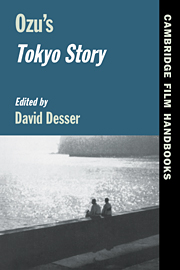Book contents
- Frontmatter
- Contents
- List of Contributors
- Introduction: A Filmmaker for All Seasons
- 1 Ozu's Tokyo Story and the “Recasting” of McCarey's Make Way for Tomorrow
- 2 Travel Toward and Away: Furusato and Journey in Tokyo Story
- 3 Ozu's Mother
- 4 Buddhism in Tokyo Story
- 5 Sunny Skies
- Filmography
- Reviews of “Tokyo Story”
- Select Bibliography
- Index
2 - Travel Toward and Away: Furusato and Journey in Tokyo Story
Published online by Cambridge University Press: 16 January 2010
- Frontmatter
- Contents
- List of Contributors
- Introduction: A Filmmaker for All Seasons
- 1 Ozu's Tokyo Story and the “Recasting” of McCarey's Make Way for Tomorrow
- 2 Travel Toward and Away: Furusato and Journey in Tokyo Story
- 3 Ozu's Mother
- 4 Buddhism in Tokyo Story
- 5 Sunny Skies
- Filmography
- Reviews of “Tokyo Story”
- Select Bibliography
- Index
Summary
At sunset
on Asaji's moors
a traveller:
oh! where
will he find lodgings?
Minamoto no Tsunenobu, 1016–97)The traveler dreams of destinations, of familiar faces, of sites whose names have been sung by poets, painters, and other travelers of the past. The suitcases are packed with necessities and with one or two objects that will lead the traveler's thoughts back to home. Loved ones, like the youngest daughter, Kyoko, in Tokyo monogatari (Tokyo Story, 1953) by Ozu Yasujiro, might go to see the traveler off at the station.
As we all know, however, the destination is not always as imagined. Once-familiar faces have aged, perhaps growing into more rigid masks with the years. Children seen years ago might be transformed completely. The splendors of one's destination might be as tarnished as an old brass pot too long in need of cleaning.
Then again, there is another possibility: someone at the end of the journey who had seemed a relative stranger could be discovered to be warm and caring, like Noriko, the young war widow of one of the sons of the Hirayama family. A city or house considered merely a point of passing could turn out to hold unexpected charms. The journey traveled is never the journey dreamed. The journey has its own logic and its own necessities. As several of the characters in Tokyo Story learn, the traveler who does not bend to this logic is broken by it.
- Type
- Chapter
- Information
- Ozu's Tokyo Story , pp. 53 - 75Publisher: Cambridge University PressPrint publication year: 1997
- 1
- Cited by



